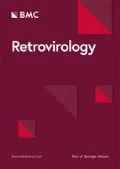Background
Recombination between viruses of the same HIV-1 subtype has been understudied primarily due to the lack of reference sequences, as well as appropriate bio-informatics tools. The introduction of recombination detection program (RDP3) made the detection of HIV-1 intra-subtype recombination feasible.
Methods
This study determined the prevalence and patterns of HIV-1 intra-subtype recombinants among female bar and hotel workers in Moshi, Tanzania. The HIV-1 env gp120 V1-C5 quasispecies from 45 subjects classified as pure HIV-1 subtypes A1, C, or D were analyzed for recombination events by RDP3.
Results
HIV-1 quasispecies with evidence for recombination were found in 89% of subjects infected with pure HIV-1 subtypes A, C, and D. Recombinant viruses were observed at both the baseline and the 12 month visits in 88% of the subjects; in 12% of subjects recombination was identified only at the later time point. Two major patterns were observed: 70% of subjects had unique recombination breakpoints without dominance of any particular variant, while in 30% of subjects a specific recombinant variant dominated in the pool of viral quasispecies.
Conclusion
A large proportion of female bar and hotel workers were infected with intra-subtype recombinant viruses. These results suggest that HIV-1 co- and super-infections are common in this population, and occur more frequently than previously thought. Intra-subtype recombination contributes to the increased viral diversity which poses a challenge to HIV-1 vaccine design.
Author information
Authors and Affiliations
Rights and permissions
This article is published under license to BioMed Central Ltd. This is an Open Access article distributed under the terms of the Creative Commons Attribution License (http://creativecommons.org/licenses/by/2.0), which permits unrestricted use, distribution, and reproduction in any medium, provided the original work is properly cited.
About this article
Cite this article
Kiwelu, I., Novitsky, V., Margolin, L. et al. Analysis of HIV-1 gp120 quasispecies suggests high prevalence of intra-subtype recombination. Retrovirology 9 (Suppl 2), P146 (2012). https://doi.org/10.1186/1742-4690-9-S2-P146
Published:
DOI: https://doi.org/10.1186/1742-4690-9-S2-P146

